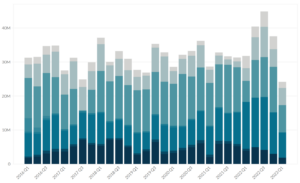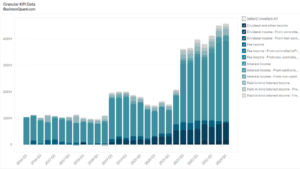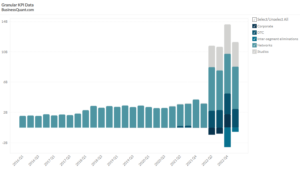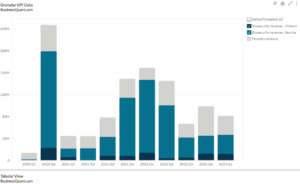
Delta Airlines’ CASM, TRASM and PRASM (2016-2023)
Exclusive Data
You need the Pro Plan to access KPI data
- Full access to the platform
- KPI data & segment financials on US stocks
- Financial data on thousands of stocks
- Download data in xlsx and csv formats
Pro Plan
$49 per month*
60% discount ends in:
.
About
More information
Subscribe to Pro or Enterprise plans to unlock this feature.
Contact the Analyst
Subscribe to Pro or Enterprise plans to unlock this feature.
Become a smarter investor today.
Access KPIs & Segment Financials on US stocks
This statistic highlights Delta Airlines’ CASM, TRASM and PRASM metrics, reported on a quarterly basis from Q1 2016 onwards.
Delta Airlines is one of the largest airlines in America and the world. Through its’s carriers, the country serves in more than 50 countries. They have a fleet of more than 800 aircraft. They have two distinct business segments – airlines and refinery. The airline segment forms the major portion of the company’s operations.
The cost per available seat mile (CASM) is used to measure the efficiency of various airlines.
Passenger Revenue per seat mile (PRASM) is used to measure the profitability of airlines.
Total Revenue per seat mile (TRASM) measures the revenue over the available seat miles.
The CASM for the first quarter of 2016 was $0.1326, which then dropped to $0.1216 for the second and third quarters before increasing to $0.143 in the last quarter. CASM in 2017 increased to $0.14 in the first quarter, $0.1323 in the second quarter, $0.1317 in the third quarter, and $0.151 in the fourth quarter. The CASM increased in 2018 to $0.1535 in the first quarter, $0.1473 in the second quarter,$0.1415 in the third quarter, and $0.154 in the last quarter. The numbers saw a small drop in 2019 when compared to the previous year to $0.151 in the first quarter,$0.1451 in the second quarter, $0.138 in the third quarter, and $ 0.1534 in the last quarter of 2019.
PRASM in the first quarter of 2016 was $0.1335 then went up to $0.1359 in the second quarter dropped to $0.1314 in the third quarter and then increased to $0.1358 in the last quarter. PRASM increased throughout 2017 to $0.141 in the first quarter, $0.147 in the second quarter, $0.142 in the third quarter, and $0.150 in the fourth quarter. It further increased in 2018 to $0.147 in the first quarter, $0.153 in the second quarter, $0.148 in the third quarter and $0.154 in the fourth quarter. This uptrend continued into 2019 and the PRASM increased to $0.148 in the first quarter, $0.158 in the second quarter, $0.150 in the third quarter, and $0.156 in the fourth quarter.
TRASM in the second quarter of 2016 was $0.158, then dropped to $0.0.151 in the third quarter before increasing to $0.161 in the fourth quarter. TRASM started to increase and went up to $0.157 in the first quarter of 2017, $0.162 in the second quarter, $0.157 in the third quarter, and $0.170 in the fourth quarter. It further increased in 2018 to $0.167 in the first quarter, $0.171 in the second quarter, $0.164 in the third quarter and $0.171 in the last quarter. The increase continued in 2019 to $0.1678 in the first quarter, $0.174 in the second quarter,$0.165 in the third quarter, and $0.174 by the end of the year.
TRASM and PRASM for Delta have been increasing year over year as well as quarter on quarter whereas the CASM has started to decline in recent years. This is a positive sign for the company as they are able to increase revenue as well as decrease their costs.
The pandemic situation will cause a slump in the company’s profits, but owing to its strong financials Delta Airlines can be expected to make a comeback once regular operations resume.
Did you like Delta Airlines’ CASM, TRASM and PRASM statistic?
Access more such KPI data points and segment financials on thousands of US stocks, with Business Quant.
You can get started here.
More data on US Stocks

Our Plans
Always know what you’ll pay. No hidden costs or surprises.
- Annual
- Monthly
60% discount till April 30
Pro
For serious investing
-
Company KPI data Access segment financials, non-GAAP metrics and KPI data from presentations and filings. Examples include financials by segment / region / product category, AT&T's broadband subscriber trends, Tesla's deliveries by model and lots more.
-
Stock research tools Features include : stock screener, stock comparison, industry financials, stock warnings, advanced charting tools, timeseries tables, scatter charts, financial statements, stock reports, SEC filings, stock ratings, institutional and insider ownership data. There are 200+ financial items and ratios on thousands of US stocks.
-
Industry data & tools Access premium operating data on 40+ industries. Examples include market share, smartphone shipments by vendor, subscribers by wireless carrier, historical gold production. There are 20,000+ such statistics.
Enterprise
For tailored workflows
-
All of Pro plan Get unfettered access to all our dashboards and dossiers.
-
Custom built features Get tailored dashboards built specially for you , based on your set of requirements, to simplify your research workflow.
-
Admin billing Back-end documentation support and multi-seat licensing.
* Billed annually, local taxes extra.
60% discount on Annual plan
Pro
For serious investing
-
Company KPI data Access segment financials, non-GAAP metrics and KPI data from presentations and filings. Examples include financials by segment / region / product category, AT&T's broadband subscriber trends, Tesla's deliveries by model and lots more.
-
Stock research tools Features include : stock screener, stock comparison, industry financials, stock warnings, advanced charting tools, timeseries tables, scatter charts, financial statements, stock reports, SEC filings, stock ratings, institutional and insider ownership data. There are 200+ financial items and ratios on thousands of US stocks.
-
Industry data & tools Access premium operating data on 40+ industries. Examples include market share, smartphone shipments by vendor, subscribers by wireless carrier, historical gold production. There are 20,000+ such statistics.
Enterprise
For tailored workflows
-
All of Pro plan Get unfettered access to all our features.
-
Custom built features Get tailored dashboards built specially for you , based on your set of requirements, to simplify your research workflow.
-
Admin billing Back-end documentation support and multi-seat licensing.
* Local taxes extra.






